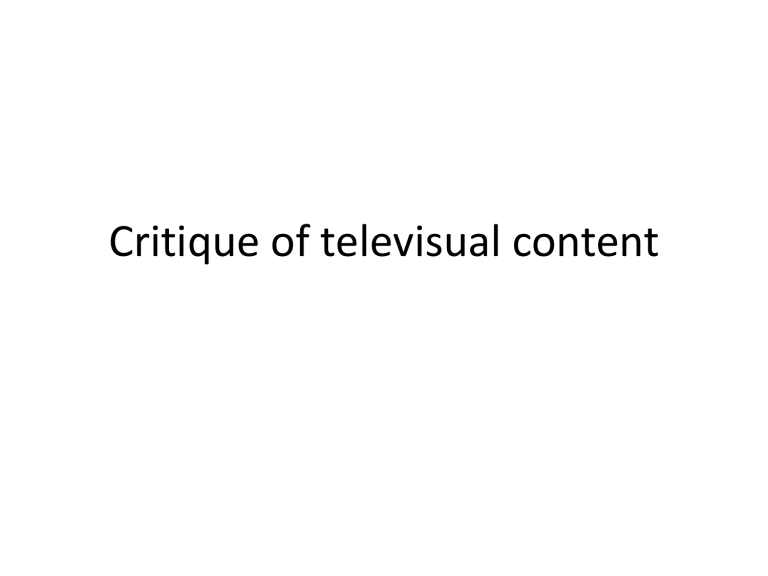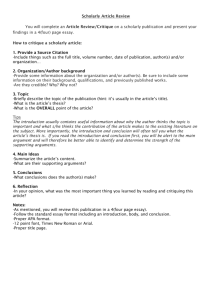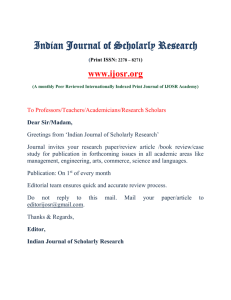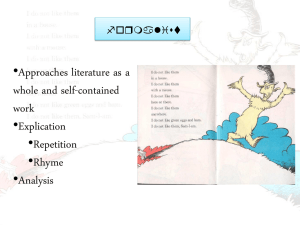Critique of televisu..

Critique of televisual content
Critique comes in many flavors
• Deep or shallow
• Broad-based or narrowly focused
• Directed toward production/content/social effects
• Qualitative v. quantitative (Butler calls this
‘empirical’)
• Professional v. amateur v. scholarly
Main foci and goals of criticism
• Entertainment-based criticism
– Help potential audience members decide whether they want to purchase a videogame, watch a TV show or movie
• Activist criticism
– Review the content of televisual media based on how it conforms to moral standards, portrays minorities, etc. in order to influence public policy or private behavior
• Scholarly criticism
– Evaluates content (individual texts or groups of texts) based on certain aesthetic standards
– Evaluates the deeper meanings of texts or groups of texts and/or their significance for society
Entertainment-based criticism
• Simplest form: Amateurs say “liked it” or
“sucks”
• Movie reviewers, etc.
– Focus on the quality of performance of the narrative/play functions
• Plot
• Characterizations/acting
• Cinematography
• Sound
• Action
Film Reviews
• “Film reviews are assessments of the aesthetic, entertainment, social and cultural merits and significance of a current film or video. Reviews tend to be short to medium length articles, often written by a single staff writer for a particular publication. In most cases, the chief aim of a review is to tell the reader whether the film is worth going to see (or buying on DVD). Although reviews are usually fairly "quick takes" on a movie, they can, in some instances, be lengthy, substantive, and very insightful.
The writing of notable critics such as Pauline Kael (The New
Yorker), James Agee (The Nation), Andrew Sarris (The
Village Voice), blur the line between popular reviews and
(more scholarly analysis).”
– Source: UC Berkeley Library
Sources
• http://www.mrqe.com/
• http://www.metacritic.com/
• http://www.rottentomatoes.com/
• http://thecriticalcritics.com/
• http://ofcs.rottentomatoes.com/
Activist criticism
• The ultimate goal is to influence the culture
– Types of content produced and distributed
– Laws concerning technology, sexual and violent content
– Technical protections, etc.
• Software to prevent children accessing porn
• Often takes on the viewpoint of a group that sees itself or its views as being ill-treated within popular culture
Activist critique
• The activist applies moral standards to the texts she studies. The forms of critique range from identifying and politicizing examples of content deemed inappropriate to carefully carried out studies of large amounts of content.
– E.g., Parents Television Council generates letterwriting campaigns when the f-word shows up on broadcast TV, but also content-analyzes primetime programming for portrayals of sex and violence
• http://www.parentstv.org/
• http://www.manaa.org/
Focus on the news
• A number of politically-motivated groups carefully monitor the news and evaluate its quality, evenhandedness, etc.
• Politically- oriented blogs are becoming monitors of each other
• http://www.fair.org/
• AJR’s list of media monitors:
– http://www.ajr.org/News_Wire_Services.asp?Me
diaType=12
Scholarly criticism
• Scholarly criticism of televisual media content has as its main goal the development of social and/or cultural theory
– Differs from activist theory in that scholarly approach is meant to generate understanding not driven by a pre-existing agenda
– Some critics try to meld the two roles, however
• Success is in the eyes of the beholder
Scholarly criticism
• Can be quite esoteric:
– We have seen how A Nightmare on Elm Street's breaking of the boundaries usually associated with the slasher subgenre allows it to complicate and confound notions of gender, identification, monstrosity, and the gaze while simultaneously extending Wes Craven's thematic preoccupation with violence as a destructive cycle and the thin line between civilization and savagery, which makes it a particularly intriguing example of Robin Wood's contention that genre films are ideologically contradictory.
• James Kendrick, Razors in the Dreamscape: Revisiting A Nightmare on Elm
Street and the Slasher Film, Film Criticism Spring 2009
Scholarly criticism
• Two main forms
– Cultural critique—development of theory and understanding with regard to the quality, meaning of televisual content
– Social critique—development of theory and understanding with regard to the social consequences of televisual content
Film criticism and analysis
• “Scholarly or focused critical writing about particular films--both current and historical--can be found in an amazingly wide variety of sources, including film journals, and publications devoted to theater, history, literature, women's studies, ethnic studies, and other disciplines. Critical/analytic film articles tend to be more academic and substantive than reviews. These articles often discuss particular films in broad social, political, and historical context. Many times the focus of these articles is on a fairly specific aspect of a film, a director's work, or a film genre.”
– Source: UC Berkeley Library
• http://www.filmcritic.com/
• UK Libraries
• http://www.ejumpcut.org/home.html
Scholarly analysis of content
• Quantitative
– Content analysis
• Qualitative
– Semiotic analysis
– Textual analysis
– Freudian analysis
– Genre analysis
– Auteur analysis
Activist/scholarly analysis
• Feminist analysis
• Cultural studies
• Racial/ethnic analysis




